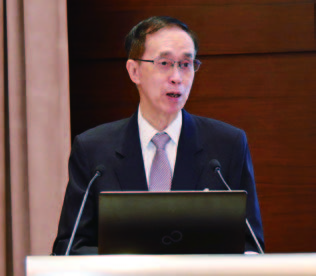Division of Work Between the Three Branches in Hong Kong’s political system was a focus of social discussion earlier. Knowing the context of this argument and the underlying concept can help us march steadily forward on the path of social construction.

A long-time translation fallacy
In response to the public’s doubts about “separation of powers”, Patrick Chan, Non-Permanent Judge of the Court of Final Appeal, gave his professional perspective on the concept of divided powers and the roles of judiciary
Chan said the customary Chinese translation of the term “separation of powers” in Hong Kong as “ 三權分立” is a fallacy. He pointed out that such a translation associates itself to confronting powers, whereas the original meaning of the term in English refers to divided and collaborative powers of the executive, legislative and judiciary branches. He also stressed that function comes before power and this order should not be reversed. “For example, a judge acquires authority from his/her function. That’s why if someone attacks the judge in court, it would involve a charge of perverting the course of justice in addition to assault.” For this reason, he believes that the Chinese translation of “separation of powers” should appropriately reflect a division of powers under which the three bodies collaborate and keep each other under check, and “ 三權分工” is a more suitable translation.
The concept of “separation of powers”
 Commenting on the concept of “separation of powers”, Chan said it actually comprises two concepts: distribution of functions, and the principle of mutual supervision with checks and balances. The former means that governance duties should be distributed across the political structure and not centralized within one body or one individual, and the different branches should not unreasonably interfere with or control each other. The latter is a legal principle that ensures all branches assigned with functions and accountabilities come under reasonable supervision as well as checks and balances of other branches. According to Chan, these two concepts are correlated yet different. They complement each other to prevent abuse of power.
Commenting on the concept of “separation of powers”, Chan said it actually comprises two concepts: distribution of functions, and the principle of mutual supervision with checks and balances. The former means that governance duties should be distributed across the political structure and not centralized within one body or one individual, and the different branches should not unreasonably interfere with or control each other. The latter is a legal principle that ensures all branches assigned with functions and accountabilities come under reasonable supervision as well as checks and balances of other branches. According to Chan, these two concepts are correlated yet different. They complement each other to prevent abuse of power.
He continued to say that in practice no government authorities are completely separated and not overlapped. They are usually executive-led or legislative-led. “Even in the US, associate justices of the Supreme Court are appointed by the President.” In Hong Kong, the Basic Law clearly provides that after the handover Hong Kong’s political structure is executiveled, under which the Chief Executive and the executive, legislative and judiciary branches serve their respective functions.
Role of the judiciary
 Chan analyzed in the context of Hong Kong’s local judiciary. He pointed out that the judiciary’s functions include enforcing the law, holding trials, interpreting and proclaiming the law, protecting human rights and freedoms, and supervising decisions and policies of the executive body as well as legislation made by the legislative body through the judiciary review procedure. He emphasized that the judiciary has no authority to formulate alternative policies for the executive branch, and judges have no right to amend or re-enact laws.
Chan analyzed in the context of Hong Kong’s local judiciary. He pointed out that the judiciary’s functions include enforcing the law, holding trials, interpreting and proclaiming the law, protecting human rights and freedoms, and supervising decisions and policies of the executive body as well as legislation made by the legislative body through the judiciary review procedure. He emphasized that the judiciary has no authority to formulate alternative policies for the executive branch, and judges have no right to amend or re-enact laws.
He indicated that when we say Hong Kong has judicial independence, it means the judiciary is independent of the executive and legislative branches, and court trials and judgments are not interfered. In his opinion, this not only safeguards the rule of law and upholds justice, but also strengthens public confidence in the rule of law and the judiciary system. It is therefore very important. However, the authority of judges has always been kept under check. Except for special circumstances, all cases must be heard openly and the judges must decide all cases based on evidence and legal principles.
Chan stressed that the court cannot stand above the executive and legislative bodies. Members of the public can file complaints if they have grievances about the performance of judges. They can also appeal against any court decision. To ensure judgment quality, the court must draw up clear judgment guidelines and provide better training, while judges should be required to give clear judgments. Chan also suggested that judges provide judgment summaries so the public can grasp the clear merit of their decisions.




